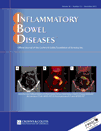Intestinal permeability and postheparin plasma diamine oxidase activity in the prediction of Crohn's disease relapse
Abstract
A method of detecting presymptomatic relapse of Crohn's disease could allow for the selective use of maintenance or intensified medical therapy in those with an increased risk of relapse. The aim of this study was to evaluate three potential laboratory markers of relapse: intestinal and gastroduodenal permeability and plasma diamine oxidase activity. Intestinal permeability (lactulose/mannitol test), gastroduodenal permeability (urinary sucrose excretion), and postheparin plasma diamine oxidase activity were serially measured in 61 adults with Crohn's disease in remission (CDAI < 150) for at least 30 days. Subjects were followed periodically for clinical relapse (CDAI > 150 and increased by at least 100 points or the need for steroids or surgery). Fourteen patients (23%) relapsed. A cut-off of 0.030 for the lactulose/mannitol ratio was defined. Those with ratios above the cutoff had a 7.0 times greater risk of relapse (p < 0.001). Three subjects who went from a normal ratio to an abnormal ratio relapsed, whereas none of 32 subjects with a repeatedly normal ratio relapsed. Sucrose excretion and plasma diamine oxidase activity did not predict relapse. Serial testing of intestinal permeability, but not of gastroduodenal permeability or plasma diamine oxidase activity, was useful in predicting relapse in asymptomatic patients.




